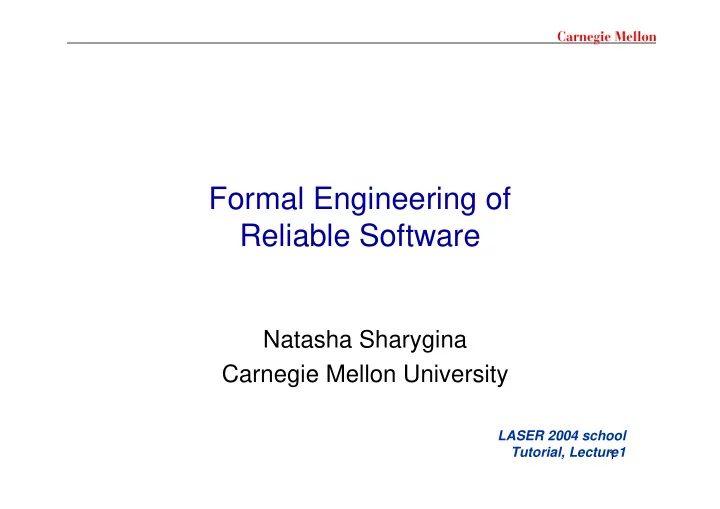

Formal Engineering of Reliable Software Natasha Sharygina Carnegie Mellon University LASER 2004 school Tutorial, Lecture1 1
Project Goals To Build Reliable and Robust Software Systems by 1) Integrating Systems Engineering with Formal Verification techniques 2) Enabling Model Checking of Realistic Software Systems 2
Outline Lecture 1, part 1 • Motivation • Model Checking Lecture 1, part 2 • State/Event-based software model checking Lecture 2 • Component Substitutability 3
Outline Lecture 1, part 1 • Motivation • Model Checking Lecture 1, part 2 • State/Event-based software model checking Lecture 2 • Component Substitutability 4
Motivation Goal: Build reliable computer systems - Secure and safe execution - Predictable designs (no unexpected behaviors) Applications: embedded systems in avionics, space, robotics, electro-mechanical engineering, etc. 5
Motivation Approach: Integrate Validation and Verification with Systems Engineering – Reasoning about system designs during their construction – Design for verification 6
ComFoRT: Component Formal Reasoning Framework SYSTEM System High-level ENGINEERING Design Specification Formal Temporal Model Properties FORMAL VERIFICATION MODEL CHECKER � � X X 7 DESIGN CORRECT BUG FOUND OUT OF RESOURCES
CCL Modeling Language A CCL system is a parallel composition of individual sequential programs, P = p 1 || … || p n , Sample commands of CCL programs: Assignments: x: = exp | x := any{exp 1 , …, exp n } Communication: : Generate e i (ID,exp) - Event generation Receive e i (ID,x) - Event consumption Compounds: if then else, while do od, switch 8
Sample CCL state model State Transition State Action Message Type State 9
Outline • Motivation • Model Checking • State/Event-based software model checking • Component Substitutability 10
Temporal Logic Model Checking • Systems are modeled by finite state machines . • Properties are written in propositional temporal logic. • Verification procedure is an exhaustive search of the state space of the design. • Diagnostic counterexamples 11
What is Model Checking? Does model M satisfy a property P ? (written M |= P) What is “M”? What is “P”? What is “satisfy”? 12
What is “M”? States: valuations to all variables a b Initial states: subset of states Arcs: transitions between states b c c Atomic Propositions: e.g. x = 5, y = true State Transition Graph or Kripke Model Observation (color): Valuation to all atomic propositions 13
Model of Computation a b a b b c c a b c c b c c State Transition Graph Infinite Computation Tree Unwind State Graph to obtain Infinite Tree. A trace is an infinite sequence of states. 14
What is “P”? Syntax: What are the property formulas? Semantics: What does it mean for model M to satisfy formula P ? Formulas: - Atomic propositions: properties of states - (Linear) Temporal Logic Specifications: properties of traces . 15
Specification (Property) Examples: Safety (mutual exclusion): no two processes can be at the critical section at the same time Liveness (absence of starvation): every request will be eventually granted Linear Time Logic (LTL) [Pnueli 77]: logic of temporal sequences. • next ( α ): α holds in the next state α • eventually( γ ): γ holds eventually γ • always( λ ): λ holds from now on λ λ λ λ λ λ • α until β : α holds until β holds 16 α α α α β β
NASA Robot Controller System v EEF Dynamics Criteria Compliance Kinematics Forces W Torques Inertia Perform ance Operational Software Components To Simulation Resource Operator Priority Setting Allocation Real-Time Control Components A ctuator C ontrol 17
Modeling of the NASA Robot Controller System Foreach Joint{ ee_reference=0; Generate EE6: MoveEndEffector(EE_ID) end_position=0; J1:Configure(Joint(Joint_ID).Joint_ID);} Idle arm_status=0; EE5: back(EE_ID) MovingJoints Initial Following A2: NotValidConfiguration(Arm ID) A1:Valid(Arm_ID) positioning Desired Trajectory EE3: BacktoIdle(EE_ID) A3:toNotValidState(Arm_ID Valid Not_Valid ) EE2: CheckLimits(EE_ID) arm_status=0; arm_status=1; ee_reference=1; ….. A4:toValidState(Arm_ID) if(Current_position>=final_point) For (int i=0;i<6;i++){ end_position=1; if (Current_position[i]>Limit[i]{ End_position=1;}} stopped …… EE4: CheckConstraints(EE_ID) A5:stop(Arm_ID) A6:terminate(Arm_ID) Checking constraints abort_var=1; || EndEffector Arm 18
Examples of the Robot Control Properties • Safety Operation: If the EndEffector reaches an undesired position, then the program terminates prior to a new move of the EndEffector AfterAlwaysUntil(undesired_position =1,ee_reference=1,abort_var=1) • Configuration Validity Check: If an instance of EndEffector is in the “FollowingDesiredTrajectory” state, then the instance of the corresponding Arm class is in the ‘Valid” state Always((ee_reference=1) ->(arm_status=1) • Control Termination: Eventually the robot control terminates EventuallyAlways(abort_var=1) 19
What is “satisfy”? M satisfies P if all the reachable states satisfy P Different Algorithms to check if M |= P . - Explicit State Space Exploration For example: Invariant checking Algorithm. 1. Start at the initial states and explore the states of M using DFS or BFS. 2. In any state, if P is violated then print an “error trace”. 3. If all reachable states have been visited then say “yes”. 20
State Space Explosion Problem: Size of the state graph can be exponential in size of the program (both in the number of the program variables and the number of program components ) M = M 1 || … || M n If each M i has just 2 local states, potentially 2 n global states Research Directions: State space reduction 21
State Space Explosion Principal Approaches to State Space Reduction: • Abstraction (elimination of details irrelevant to verification of a property) • Compositional reasoning (reasoning about parts of the system) • Symbolic Verification (BDDs represent state transition diagrams more efficiently) • Partial Order Reduction (reduction of number of states that must be enumerated) • Other (symmetry, cone of influence reduction, ….) 22
Systems engineering and model checking Principal Approach • Component-based system design • Compositional reasoning (reasoning about parts of the system) 23
Components Compositional reasoning reduces reasoning about entire system to reasoning about individual parts - Decompose the model: M = M1 || M2 Partition global properties into local properties: P= P1 ∧ P2 - - Show that M1 |= P1 and M2 |= P2 Component-based design Library of verified components � predictable designs - 24
Recommend
More recommend